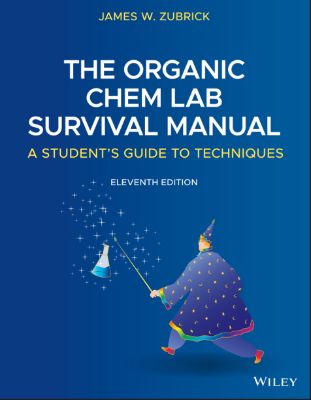The Organic Chem Lab Survival Manual: A Student's Guide to Techniques

Námskeið
- EFN309G Lífræn efnafræði 1
Ensk lýsing:
This Organic Chem Survival Manual, 9e presents the basic techniques of the organic chemistry laboratory with an emphasis on doing the work correctly the first time. New to this edition are: Safety in the laboratory, always a primary concern, one now has to consider the addition of such technology as the iPad, the Nook, the Kindle, and even text messaging where applicable; Microscale where applicable, has been reviewed and updated; A discussion of the technique of Attenuated Total Reflectance and associated practices has been added to the section on Infra-Red Spectroscopy; The Nuclear Magnetic Resonance discussion and presentation has been re-worked such that the different methods of sample preparation, and instrument operation for continuous-wave and FT-NMR have been made to contrast more sharply.
Lýsing:
Teaches students the basic techniques and equipment of the organic chemistry lab -- the updated new edition of the popular hands-on guide. The Organic Chem Lab Survival Manual helps students understand the basic techniques, essential safety protocols, and the standard instrumentation necessary for success in the laboratory. Author James W. Zubrick has been assisting students navigate organic chemistry labs for more than three decades, explaining how to set up the laboratory, make accurate measurements, and perform safe and meaningful experiments.
This practical guide covers every essential area of lab knowledge, from keeping detailed notes and interpreting handbooks to using equipment for chromatography and infrared spectroscopy. Now in its eleventh edition, this guide has been thoroughly updated to cover current laboratory practices, instruments, and techniques. Focusing primarily on macroscale equipment and experiments, chapters cover microscale jointware, drying agents, recrystallization, distillation, nuclear magnetic resonance, and much more.
This popular textbook: Familiarizes students with common lab instruments Provides guidance on basic lab skills and procedures Includes easy-to-follow diagrams and illustrations of lab experiments Features practical exercises and activities at the end of each chapter Provides real-world examples of lab notes and instrument manuals The Organic Chem Lab Survival Manual: A Student’s Guide to Techniques, 11 th Edition is an essential resource for students new to the laboratory environment, as well as those more experienced seeking to refresh their knowledge.
Annað
- Höfundur: James W. Zubrick
- Útgáfa:11
- Útgáfudagur: 12/2019
- Hægt að prenta út 10 bls.
- Hægt að afrita 2 bls.
- Format:ePub
- ISBN 13: 9781119607861
- Print ISBN: 9781119608554
- ISBN 10: 1119607868
Efnisyfirlit
- Cover
- Preface to the Eleventh Edition
- Text Figures: Quick Reference Guide
- Chapter 1: Safety First, Last, and Always
- Accidents Will Not Happen
- Disposing of Waste
- Safety Data Sheets
- Green Chemistry
- An iBag for Your iThing
- Exercises
- Chapter 2: Keeping a Notebook
- A Technique Experiment
- A Synthesis Experiment
- The Six Maybe Seven Elements in Your Experimental Write-up
- The Acid Test
- Notebook Mortal Sin
- Calculation of Percent Yield (Not Yeild!)
- Estimation Is Your Friend
- Notes From My Bench
- Exercises
- Chapter 3: Mining Your Own Data
- Google and the Wiki
- The Terphenyl Anomaly
- Exercises
- Chapter 4: Jointware
- Stoppers with Only One Number
- Another Episode of Love of Laboratory
- Hall of Blunders and Things Not Quite Right
- The O-Ring and Cap Branch Out
- Greasing the Joints
- Storing Stuff and Sticking Stoppers
- Corking a Vessel
- Chapter 5: Microscale Jointware
- Microscale: A Few Words
- Uh-Oh Rings
- The O-Ring Cap Seal
- The Comical Vial (That’s Conical!)
- The Microscale Drying Tube
- Gas Collection Apparatus
- Chapter 6: Other Interesting Equipment
- Funnels, and Beakers, and Flasks—Oh My!
- The Flexible Double-Ended Stainless Steel Spatula
- Chapter 7: Pipet Tips
- Pre-Preparing Pasteur Pipets
- Pipet Cutting
- Pipet Filtering—Liquids
- Pipet Filtering—Solids
- Chapter 8: Syringes, Needles, and Septa
- The Rubber Septum
- Chapter 9: Clean and Dry
- Drying Your Glassware When You Don’t Need To
- Drying Your Glassware When You Do Need To
- Chapter 10: Drying Agents
- Typical Drying Agents
- Using a Drying Agent
- Following Directions and Losing Product Anyway
- Drying Agents: Microscale
- Drying in Stages: The Capacity and Efficiency of Drying Agents
- Exercises
- Chapter 11: On Products
- Solid Product Problems
- Liquid Product Problems
- The Sample Vial
- Hold It! Don’t Touch That Vial
- Chapter 12: The Melting-Point Experiment
- Sample Preparation
- Melting-Point Hints
- The Mel-Temp Apparatus
- The SRS DigiMelt
- The Fisher-Johns Apparatus
- The Thomas-Hoover Apparatus
- Using the Thiele Tube
- Exercises
- Chapter 13: Recrystallization
- Finding a Good Solvent
- General Guidelines for a Recrystallization
- Gravity Filtration
- The Buchner Funnel and Filter Flask
- The Hirsch Funnel and Friends
- Activated Charcoal
- The Water Aspirator: A Vacuum Source
- The Water Trap
- Working with a Mixed-Solvent System—The Good Part
- A Mixed-Solvent System—The Bad Part
- Salting Out
- World-Famous Fan-Folded Fluted Paper
- Exercises
- Chapter 14: Recrystallization: Microscale
- Isolating the Crystals
- Craig Tube Filtration
- Centrifuging the Craig Tube
- Chapter 15: Extraction and Washing
- Never-Ever Land
- Starting an Extraction
- Dutch Uncle Advice
- The Separatory Funnel
- How to Extract and Wash What
- Exercises
- Chapter 16: Extraction and Washing: Microscale
- Mixing
- Separation: Removing the Bottom Layer (Fig. 16.1)
- Separation: Removing the Top Layer (Fig. 16.2)
- Separation: Removing Both Layers
- Chapter 17: Sources of Heat
- Boiling Stones
- The Steam Bath
- The Bunsen Burner
- The Heating Mantle
- Proportional Heaters and Stepless Controllers
- Exercise
- Chapter 18: Clamps and Clamping
- Clamping a Distillation Setup
- Clipping a Distillation Setup
- Chapter 19: Distillation
- Distillation Notes
- Class 1: Simple Distillation (Fig. 19.1)
- The Distillation Example
- The Distillation Mistake
- Class 2: Vacuum Distillation
- Class 3: Fractional Distillation
- Azeotropes
- Class 4: Steam Distillation
- Steam Distillation Notes
- Simulated Bulb-to-Bulb Distillation: Fakelrohr
- Exercises
- Chapter 20: Microscale Distillation
- Like the Big Guy
- Microscale Distillation II: The Hickman Still
- Chapter 21: The Rotary Evaporator
- Exercises
- Chapter 22: Reflux and Addition
- Standard Reflux
- A Dry Reflux
- Addition and Reflux
- Exercise
- Chapter 23: Reflux: Microscale
- Addition and Reflux: Microscale
- Chapter 24: Sublimation
- Chapter 25: Microscale Boiling Point
- Microscale Boiling Point
- Ultramicroscale Boiling Point
- Chapter 26: Chromatography
- Adsorbents
- Separation or Development
- The Eluatropic Series
- Chapter 27: Thin-Layer Chromatography: TLC
- We Don’t Make Our Own TLC Plates Any More, But…
- The Plate Spotter
- Spotting the Plates
- Developing a Plate
- Visualization
- Interpretation
- Multiple Spotting
- Cospotting
- Other TLC Problems
- Preparative TLC
- Exercises
- Chapter 28: Wet-Column Chromatography
- Preparing the Column
- Compounds on the Column
- Visualization and Collection
- Wet-Column Chromatography: Microscale
- Flash Chromatography
- Microscale Flash Chromatography
- Exercises
- Chapter 29: Refractometry
- The Abbé Refractometer
- Before Using the Abbé Refractometer: A Little Practice
- Using the Abbé Refractometer
- Refractometry Hints
- Chapter 30: Gas Chromatography
- The Mobile Phase: Gas
- GC Sample Preparation
- GC Sample Introduction
- Sample in the Column
- Sample at the Detector
- Electronic Interlude
- Sample on the Computer
- Parameters, Parameters
- Exercises
- Chapter 31: HP Liquid Chromatography
- The Mobile Phase: Liquid
- HPLC Sample Preparation
- HPLC Sample Introduction
- Sample in the Column
- Sample at the Detector
- Sample on the Computer
- Parameters, Parameters
- Exercises
- Chapter 32: Infrared Spectroscopy: (And a Bit Of UV-VIS, Too)
- Molecules as Balls on Springs
- AH, Quantum Mechanics
- The Dissonant Oscillator
- But Wait! There’s More
- More Complicated Molecules
- Correlation Tables to the Rescue
- Troughs and Reciprocal Centimeters
- Some Functional Group Analysis
- A Systematic Interpretation
- IR Sample Preparation
- Running the Spectrum
- Interpreting IR Spectra—Finishing Touches
- The Fourier Transform Infrared (FTIR)
- A Reflectance Attachment: Something to Think About
- And UV-VIS Too!
- Electrons Get to Jump
- Instrument Configuration
- Exercises
- Chapter 33: Nuclear Magnetic Resonance
- Nuclei Have Spin, Too
- The Magnetic Catch
- Everybody Line Up, Flip, and Relax
- A More Sensitive Census
- The Chemical Shift
- T for One and Two
- Be It Better Resolved…
- Incredibly Basic FT-NMR
- NMR Sample Preparation
- Some NMR Terms and Interpretations
- Exercises
- Index
- End User License Agreement
UM RAFBÆKUR Á HEIMKAUP.IS
Bókahillan þín er þitt svæði og þar eru bækurnar þínar geymdar. Þú kemst í bókahilluna þína hvar og hvenær sem er í tölvu eða snjalltæki. Einfalt og þægilegt!Rafbók til eignar
Rafbók til eignar þarf að hlaða niður á þau tæki sem þú vilt nota innan eins árs frá því bókin er keypt.
Þú kemst í bækurnar hvar sem er
Þú getur nálgast allar raf(skóla)bækurnar þínar á einu augabragði, hvar og hvenær sem er í bókahillunni þinni. Engin taska, enginn kyndill og ekkert vesen (hvað þá yfirvigt).
Auðvelt að fletta og leita
Þú getur flakkað milli síðna og kafla eins og þér hentar best og farið beint í ákveðna kafla úr efnisyfirlitinu. Í leitinni finnur þú orð, kafla eða síður í einum smelli.
Glósur og yfirstrikanir
Þú getur auðkennt textabrot með mismunandi litum og skrifað glósur að vild í rafbókina. Þú getur jafnvel séð glósur og yfirstrikanir hjá bekkjarsystkinum og kennara ef þeir leyfa það. Allt á einum stað.
Hvað viltu sjá? / Þú ræður hvernig síðan lítur út
Þú lagar síðuna að þínum þörfum. Stækkaðu eða minnkaðu myndir og texta með multi-level zoom til að sjá síðuna eins og þér hentar best í þínu námi.
Fleiri góðir kostir
- Þú getur prentað síður úr bókinni (innan þeirra marka sem útgefandinn setur)
- Möguleiki á tengingu við annað stafrænt og gagnvirkt efni, svo sem myndbönd eða spurningar úr efninu
- Auðvelt að afrita og líma efni/texta fyrir t.d. heimaverkefni eða ritgerðir
- Styður tækni sem hjálpar nemendum með sjón- eða heyrnarskerðingu
- Gerð : 208
- Höfundur : 6481
- Útgáfuár : 2012
- Leyfi : 380


